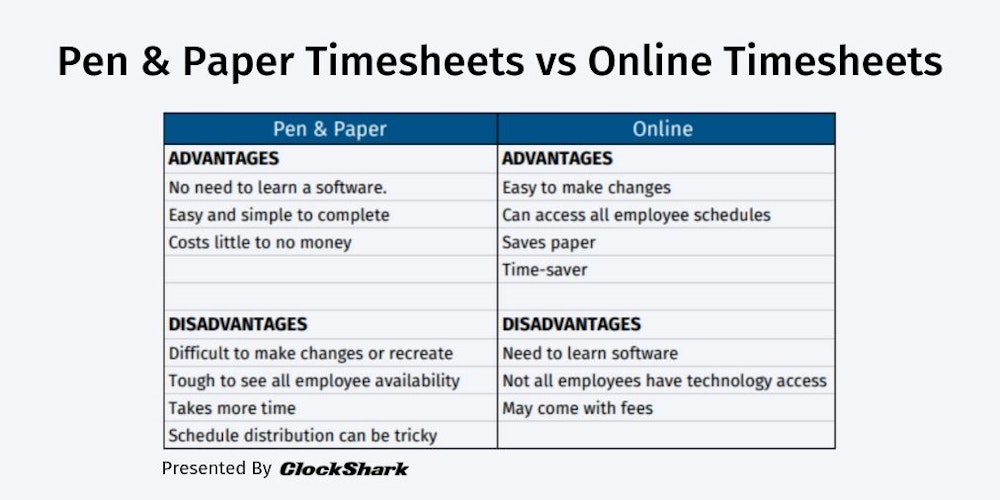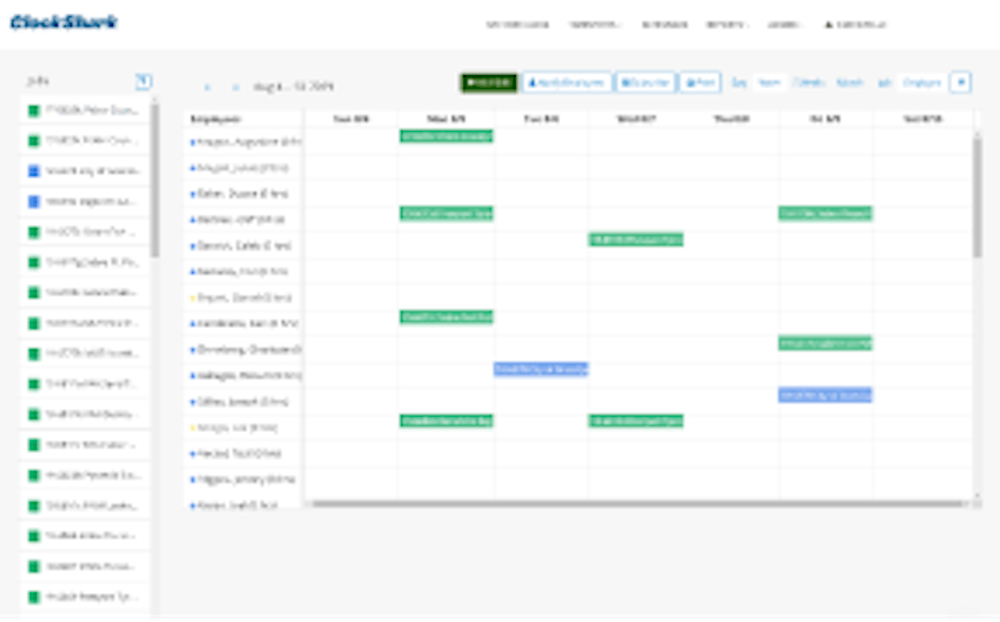Business owners have a lot on their plates. Running a business requires attention to detail, careful planning, and precise organization. One task that can be particularly time-consuming is solving the complex puzzle of employee scheduling.
In fact, managers spend about [2.21 hours](http://www.timeforge.com/site/scheduling-facts/restaurant-scheduling-statistics-2/) of their week scheduling employees, that’s 5.52% of the workweek.
Juggling who can work when, overtime, and time off requests can seem daunting. Dedicating large portions of time to schedule can also eat away at the time that can be used to grow a business and start new projects.
Finding an efficient schedule maker can streamline operations. Simplifying employee scheduling saves time and benefits its employees. Luckily, business owners have a wide variety of tools available that they can use to make schedule-making pain-free.
How Do I Create a Work Schedule for my Employees?
Business owners need to consider the needs of their business specifically. Some variables to consider include employee availability, time-off requests, and overtime. Some business owners may even find that their needs vary shift-to-shift, such as restaurant owners.
Employee needs are also important variables. What if multiple employees ask off for the same time? Aside from time-off and overtime, owners need to consider part-time vs. full-time employee scheduling and make sure employees with the right skill set are being scheduled for the jobs.
Finally, business owners need to keep distribution methods in mind. Once a schedule is made, what is the best way to get it to employees?
An efficient scheduling method takes into consideration all of these variables and should minimize the complexities that come with creating a schedule. There are a lot of tools available to help managers create schedules, so let's take a look at a few:
Scheduling Basics
1. Old School: Pen and Paper
Pen and paper-- the original scheduling tool. It may seem outdated, but this method still has advantages! The simple nature of using pen-and-paper for scheduling does not require any training. As long as you know your business’s needs are being met it can be a reliable way to schedule employees.
Unlike scheduling software, there is rarely a learning curve or updates that need getting used to when it comes to pen-and-paper.
The cons
On the flip side, the pen-and-paper scheduling process isn’t without drawbacks. For starters, it can be time-consuming. Taking into account each employee’s needs as well as what the business needs to run smoothly can turn into a complex process with pen-and-paper scheduling.
On top of that, distributing a physical schedule can be tricky. Will you post it where you know everyone will see it? Send a photo? Distribute copies?
Finally, what if a change needs to be made? Changes in a pen-and-paper schedule can be difficult to share with employees who may have already seen the original schedule.
Paper vs apps
From the outside, software scheduling may seem like a challenge. It takes time to get acquainted with a new process. It goes without saying that if learning and using a software scheduling tool is too time-consuming, it isn’t a more effective method than pen-and-paper.
Aside from that, the benefits of scheduling software tools are obvious and typically make them the better choice when it comes to making employee schedules.
For starters, distribution is simplified when using technological tools to make schedules. Studies from Pew Research show that 77 percent of Americans have a smartphone, and by extension access to a wide range of apps. This means that there are nearly endless options for making and distributing a schedule using scheduling apps.
Many scheduling tools have apps that coincide with them, meaning employees can access a finished schedule through an app on their phone and be updated if and when there are changes to the schedule. This also means using less paper, which means helping the environment!
Requiring employees to have an app connected to your scheduling software might seem like too much to ask, but luckily there are apps available just for communication. These make it easy to send a schedule created using another tool to employees.
Another advantage of software scheduling tools is that schedules are automatically saved any time one is created. This means that managers can save time by using an old schedule as a template for a new one.
An additional consideration to make when selecting software is the option of cloud-based tools. Software that has cloud capabilities makes sharing finished schedules with authorized users easy. With the click of a button, schedules can be accessed simply by logging into a shared drive or account.
There are a lot of options available for business owners looking for a new, efficient method for creating employee schedules. Every business is unique, so the tools that work best for one business will be different from another.

2. Word Processing Systems
Word processing systems are where pen-and-paper scheduling and software meet. While the differences between word processing and actual pen and paper methods are few and far between, it can certainly get the job done. Word processing programs also simplify schedule distribution for those who find pen-and-paper employee scheduling works best.
Microsoft Word has forms pre-loaded into the system that can be modified by the user to create a form or schedule that works best for them. The downside to Microsoft word is that these forms are often counter-intuitive and frustrating.
Google Docs works similarly to Microsoft Word. The key difference here is that Google Docs can be viewed online or in a mobile app by anyone who has been granted access. The issues found in formatting and altering a schedule remain, but the cloud-based aspect of Google Docs eliminates the issue of re-sending schedules that have been changed.
Instant access to the schedule means business owners spend less time sending and resending schedules employees can spend less time waiting around trying to figure out when they work. This means more time spent actively growing a business and making sure it runs smoothly.
3. Spreadsheets
Spreadsheets work in a similar way to word processors. The benefit of using spreadsheet software for scheduling is the built-in format of rows and columns.
Spreadsheets can be customized to fit specific needs, but having a format ready to go from the beginning helps make sure you aren’t reinventing the wheel when creating a schedule. Formatting is typically less frustrating, and the system usually adjusts automatically around the changes the user wants to make.
Microsoft Excel is one example of spreadsheet software, the cloud-based aspect of Google Sheets carries the same added benefits that Google Docs has over Microsoft Word. Where distribution is a major stumbling block for Excel, Google Sheets has the same easy accessibility as Google Docs. After making a schedule, a link to the schedule can be sent to employees to view from their computer or smartphone.
4. Calendars
Another useful tool for scheduling is calendar software.
Calendar software is a great tool to use when more basic methods such as pen and paper, word processing, or spreadsheets just aren’t getting the job done.
Microsoft Outlook is one example of calendar software. With hours, days, weeks, and months already in place, the user only needs to format it to fit their needs.
This tool can be a step up from others discussed, however it doesn’t come without drawbacks.
It can be useful, but it was not created with group scheduling in mind. Ultimately it was intended for a single user scheduling, not for scheduling all the employees that make a business function.
On top of that, users will find that overlapping schedules or complex schedules are not exactly compatible with Outlook.
On the other hand, cloud-based Google Calendar allows the user much more freedom than some of its counterparts. Creating a schedule is much more flexible and has the added benefit of easy distribution through the cloud. Just like the other cloud-based programs discussed, authorized users can view and edit Google Calendars online.
Changes can be viewed instantly, and users can even add their own notes. For example, an employee who has a scheduling conflict can leave a note on the created schedule. Then, the schedule can be modified to make any accommodations necessary and the newest version is available immediately to everyone.
Still, the issues that plague Outlook also appear with Google Calendar. Overlapping shifts and complex scheduling that comes with any business are issues that business owners should consider when choosing the tools they use for employee scheduling methods.
5. Distribution Tools
Creating a schedule is only half the battle. Once you’ve carefully crafted a schedule that meets the needs of the business and employees alike, you have to make sure everyone sees it. Not only that, you need to be sure that the schedule is easily accessible to employees and that any changes made after distributing it are also seen by everyone.
6. Group Chats
One way to share a schedule is through a group messaging app such as WhatsApp. These platforms can be a great tool for communicating with employees since apps like WhatsApp are often already used in a social setting.
Say you create a schedule in Google Sheets. Once your schedule is done, you can text the link out to an employee group chat for everyone to access. Any subsequent changes made can also be shared in the group.
This is a quick and easy way to make sure all employees are on the same page-- you just need to make sure that all employees have a smartphone.
7. Email Lists
While an email list may seem more old-fashioned than a messaging app, email lists can serve the same purpose while avoiding unnecessary notifications from piling up in a group messaging app.
For example, say you’ve texted a link to the latest schedule to a group of your employees. A group message can quickly turn to chaos if you’re communicating with a large group of employees who start to chime in with any conflicts or comments.
An email list allows employees to respond only to you with any questions or concerns.
8. Dropbox
Dropbox is another useful tool for distributing schedules. Once your schedule is created, simply upload it to dropbox and make sure access is given to everyone who needs to see it. Authorized individuals can receive a notification from Dropbox letting them know that the latest schedule is available.
This method is useful because there are multiple ways employees can receive notifications. Some employees may have limited texting capabilities on their phone plans and want to receive emails, while others may not check their email often and prefer to have notifications texted to them. You can also make sure all bases are covered by sending a text AND an email to employees letting them know the schedule is up.
If you need to make changes to the schedule it’s easy to simply upload a revised version and send out another notification.
9. Google Drive
Like Dropbox, but with the added benefit of cloud storage. Google Drive is a free storage program that doesn’t require you or your employees to download multiple apps to view a schedule.
Compatible with any of the Microsoft and Google programs already mentioned, Google Drive is a free and efficient way to upload a schedule and distribute it to a large group of people. Managers can create shared folders within the drive and allow access to whoever needs to view them.
This means that employees with different duties can have folders dedicated to their schedules and tasks. Management can have access to a folder, accounting access to theirs, and so on. All employees need is a device to access the internet.
While it doesn’t cover the creation aspect of employee scheduling, Google Drive is a great tool for distributing a schedule created using any method.
As useful as these tools are, at the end of the day they individually are not geared towards managing schedules for multiple people. Business owners need to consider ways in which these tools can work together and streamline the scheduling process.
Is There a Scheduling App?
Business owners who have more complex scheduling needs often find that they need a combination of tools to create a schedule in a way that is most efficient for everyone.
This is where scheduling apps come in.
Scheduling apps harness a variety of tools to create user-friendly scheduling software. Good scheduling apps that can be adapted to fit the needs of individual users and businesses. Like any kind of software, there are a lot of options out there. Here are a few that stand out:
1. Clockshark

ClockShark is a cloud-based software with scheduling and timekeeping capabilities. Designed with businesses with employees out in the field in mind, it features a user-friendly employee scheduling app and cloud connection for access anywhere at any time.
On top of that, if the schedule changes ClockShark instantly sends a notification to employees. This means that they are always in the know as far as where to be and when. As a bonus, it takes into account paid time off accruals and can create PTO plans quickly and efficiently.
Employee scheduling is just one of the many features ClockShark offers. Time tracking capabilities and detailed reporting features make Clockshark a great tool.
2. 10 to 8
10 to 8 is a program that syncs with tools you might already use, such as Outlook or Google Sheets, and has 24/7 appointment booking. 10 to 8 is also compatible with commonly used programs like Google Analytics and Slack, making it a good tool for scheduling.
3. Doodle
Doodle is a simple scheduling app designed to keep track of when employees are scheduled to work. It’s cloud-based, so it’s easy to make sure employees can see a schedule quickly and easily. Updates are also easy to make and quick to share.
Doodle works great for small-scale operations, but might not be able to handle complex scheduling. It’s a great option for small businesses that only have a handful of employees to schedule.
4. Shifty
The name might sound, well, shifty, but Shifty is a great scheduling app for small businesses and individuals. Users can schedule multiple employees across multiple shifts with a user-friendly drag-and-drop feature. Drag-and-drop lets you quickly schedule employees and assign them tasks during shifts.
The downside comes with email distribution. If the email goes to spam or junk, then employees won’t see it. This means verifying that all employees received the schedule, as well as verifying that they saw any changes added later on.
5. Humanity
Humanity helps optimize scheduling for employees and business owners. features drag-and-drop scheduling and uses analytics to predict a business’s changing needs.
Cloud-based and mobile-focused, Humanity is easily accessible by managers and employees alike. It also has a shift swapping feature for employees to trade shifts on their own. This helps eliminate the middle-man work management faces when employees have scheduling conflicts.
It also monitors details like overtime, mandatory breaks, and more.
6. When I Work
Another drag-and-drop contender, When I Work offers users time-saving employee scheduling. When I work is also web-based, giving you the ability to log on without needing to download and install a program.
The app also comes with 24/7 mobile access, keeping employees connected through text and email alerts. When a shift needs filling, the app displays employees qualified for the job and available to work. The mobile app notifies eligible and qualified employees when a shift is available by sending out a notification.
7. Sling
Sling wants to keep schedule making simple and speedy. It combines calendar layout with cloud-based technology to allow easy and reliable distribution.
Sling works with you. It gives you a warning for overlapped shifts and sends push notifications to employees about no-shows. It advertises open shifts to employees to make sure business needs are met. You can even color-code employees to streamline and organize scheduling.
Remember, no two businesses will have the same needs. Different needs mean different scheduling methods. Whether you use pen and paper or the latest cutting-edge software, make sure it checks off all the needs for your business!





